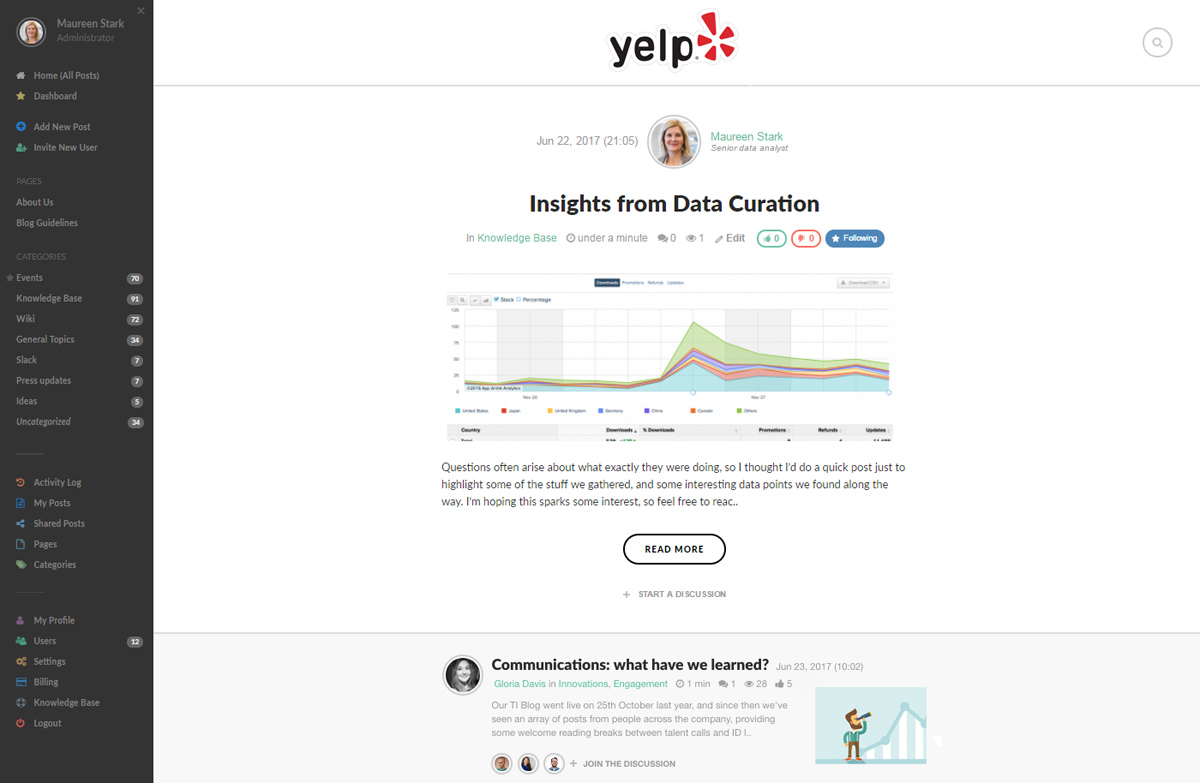
Having a blog on your website is a great way to increase traffic and connect with your audience and potential customers. With the rise of content marketing, having a blog section on your site became a necessity, not something you would do only if you had some spare time.
And while this is a great way to answer the questions of your potential prospects, it is not really a place to discuss internal issues and news you’d rather share only with your employees. This is where an internal company blog can help.
But what does an internal company blog cover and how good is your company at separating it from your regular blog? What even is the difference between the two and do you even need both?
In this article, we take a look at how exactly is an internal company blog different from a regular blog, and why maintaining one is a good idea.
The Aims of an Internal Company Blog
An internal company blog is open only to the employees of your company.
To set up your internal blog you can use a specialized internal blog tool such as BlogIn, or you can set it up using your custom tools.

Probably the most important thing is that the tool you choose is simple and easy to use so that all your employees can easily join and participate.
Improve Communication Between Employees
Communication improves morale, teamwork, and productivity, with stats showing that productivity jumps by as much as 25% when team members feel involved in the conversation. With an internal blog, any employee is free to post and chat with their colleagues, as well as executives.
If you need to convey valuable information to your employees super fast, an internal blog is a great way to do it.
There are some communication problems tools like Slack aren’t suited for, (for example, long-form content) and this is where an internal blog can be your solution.
Raise Internal Issues and Promote Discussion
What’s working and what isn’t working in your organization? A great way to find out and bounce ideas around is with your internal blog.
Internal blogs can indeed be used to inspire new discussions so that internal issues within your organization are easier to overcome. You never know, it could be the person you least expect who brainstorms an amazing idea to push your company forward.
Share Company News
Has something of note happened at your company recently? You can share news about it via your internal blog.
An internal blog gives you the chance to group relevant information together and share it via a single post with your whole team. This saves time and ensures that everyone continues to sing from the same song sheet.
The important option to have on your internal blog is to be able to assign different roles or access levels to your users so you can control who can publish new content and who can only read.
Create a Sense of Community
Communities are a powerful thing. When you create a sense of community among your team, you’re onto a winner.
Because an internal blog brings together employees and executives from all departments, they’re a great place for people to rally, bond, and work together.
In BlogIn, you can use teams to organize your users into logical groups and tailor content and notifications for each team.
The Aims of an External Blog
The external blog is your standard blog section that can be seen on almost any site. Sometimes it hides behind names like resources/guides/news, but they all have basically the same purpose;
-
present useful guides
-
cover important company and industry news
-
tell your story and promote your products and services to all potential buyers that find their way to the blog
Educate Your Audience On Your Brand, Niche, and Products
External blogs are a great way to reach new customers by educating them about your business, niche, and products. How-to guides, infographics, explainer videos, list-based articles, and roundups are some of the more commonly used content types.
While you should put some thought into choosing the right type of content for the topic you plan to cover, as long as you concentrate on offering actionable and valuable information to your customers and visitors, you are on the right track.
As millennials are becoming a major part of the “buying force”, having content that tells an authentic story, promotes the right values, and educates the buyer is really important. After all, those are the qualities millennials are looking for.
To Improve SEO
With the rise of content marketing, well-researched blog posts have become the ultimate wingman for boosting your Google rankings and subsequently increasing organic traffic.
By picking the right topics based on careful keyword research, you can make your website more visible to the people that might be interested in whatever you are selling. Having more content on your blog also results in more unique material to share on your social channels which definitely doesn’t hurt.
Position You as the Expert
An external blog is a great place to showcase your in-depth knowledge of your industry and products. The more you know, and the more you show your customers that you know, the more they will begin to see you as the go-to experts they should be giving their money to. This is one of the best ways to improve brand trust and authority.
The Biggest Difference
The biggest difference between the two blogs, then, is that an external blog has to be super professional and well-written (even though this can also differ depending on who your audience is), while an internal blog is much more relaxed.
This is because the target audience is different. With an external blog, you’re targeting existing and potential customers, while with an internal blog you’re talking to your team members, colleagues, and friends.
Why You Need an Internal Blog
There are many reasons why a company should start an internal blog. Let’s cover the most common ones.
You’re looking to engage employees and increase productivity
Committed employees who post to your internal blog and discuss ideas with their colleagues will become even more engaged. And when they become more engaged, their productivity will increase, with stats showing that 78% of engaged workers will work harder.
An internal blog, then, is a great way to show your team that their work has value and that it means something.

You want to improve team morale
Team morale is so important. When teams are brought together via the company’s internal blog, they feel a part of something. And when they feel a part of something, their morale increases.
Your internal blog should be a place to share news and values, but it should also be a place to encourage bonding and rapport among your team members.
You want to have a better overview of your internal processes
Managers need feedback - they feed off it. Feedback shows them what’s working and what isn’t at the top and bottom of your company.
Via an internal blog, managers can listen to their employees and get a greater understanding of what makes the organization tick, as well as what needs to be improved. An internal company blog can become a great asset for picking up the information you would otherwise have to dig up by doing a lot of 1 to 1 interviews.
Key Takeaways
To sum up, internal blogs and external blogs are both important to all medium to large organizations. An external blog helps you bring in and convert more leads, while an internal blog boosts morale, teamwork, and productivity - ensuring that people you just converted get quality service and products.
If this post convinced you to think about starting an internal blog, here’s an excellent guide that will help you out.
Dario Supan is a content strategist and editor at Point Visible, a marketing agency providing custom outreach and link-building service. When he isn’t neck-deep in outreach projects and editorial calendars, you will most likely find him designing a custom graphic for his next exciting post.
